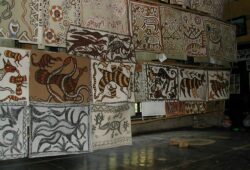The Art of Collage: Exploring the Realm of Visual Fusion
 Posted On
Posted On
Collage art, a medium that has captivated artists and audiences for over a century, combines disparate elements to create a visually striking and thought-provoking composition. By merging various materials, textures, and images, collage artists transform ordinary objects into extraordinary works of art, challenging traditional notions of representation and narrative. In this article, we delve into the world of collage art, exploring its origins, techniques, and the diverse range of artists who have embraced this captivating form.
Origins of Collage Art: Collage art traces its roots back to the early 20th century when artists such as Pablo Picasso and Georges Braque pioneered the technique as part of the Cubist movement. Picasso’s groundbreaking artwork “Still Life with Chair Caning” (1912) is often cited as the first example of collage art. By incorporating materials such as newspaper clippings and wallpaper into their paintings, these artists shattered traditional perspectives and transformed two-dimensional canvases into multidimensional, tactile compositions.
Techniques and Materials: Collage art offers endless possibilities for artistic expression through its diverse techniques and materials. Artists can use a wide range of materials such as photographs, magazine cutouts, fabric, found objects, and even digital images. These materials are often glued or juxtaposed onto a surface, creating a visually striking composition.
Collage artists employ various techniques to achieve their desired effects. These may include tearing or cutting materials into desired shapes, layering and overlapping images, or using techniques like decoupage to create a seamless integration of elements. Artists also experiment with texture, employing techniques such as embossing or adding texture with gels or mediums to enhance the tactile quality of their works.

The Expressive Power of Collage: One of the most intriguing aspects of collage art is its ability to evoke a wide range of emotions and narratives. By merging disparate elements, artists can create unexpected connections and juxtapositions, challenging viewers to interpret and engage with the artwork on multiple levels. Collage art often blurs the boundaries between reality and imagination, inviting viewers to explore the hidden meanings and narratives within the composition.
Artists like Hannah Höch, a prominent figure of the Dada movement, used collage as a powerful tool for social commentary and critique. Höch’s work often incorporated images from popular magazines, challenging societal norms and questioning the role of women in the early 20th century.
Contemporary Collage Artists: Collage art continues to evolve and thrive in contemporary art practice. Artists such as Romare Bearden, Fred Tomaselli, and Kara Walker have made significant contributions to the medium, exploring themes of identity, race, and culture through their innovative collage techniques.
In recent years, digital collage has gained prominence, blending traditional techniques with digital tools and platforms. Artists utilize image-editing software and online resources to create intricate, visually stunning compositions, often incorporating elements of pop culture and current events.
Collage art remains a vibrant and dynamic medium that challenges traditional notions of art-making. Through its unique ability to fuse disparate elements into a cohesive whole, collage art invites viewers to question, interpret, and engage with the world in new and exciting ways. With its rich history and boundless possibilities, collage art continues to captivate and inspire artists and audiences alike.



